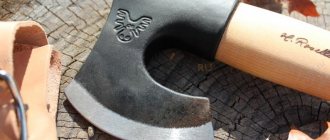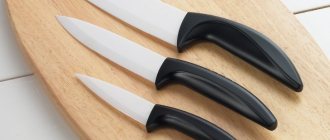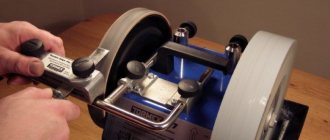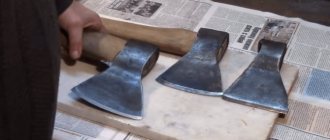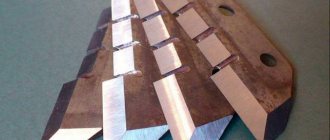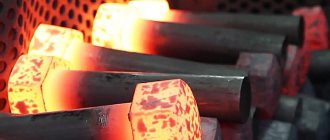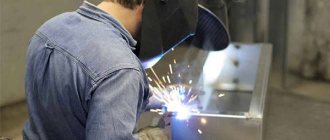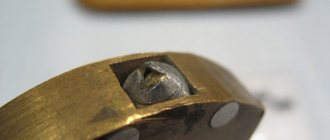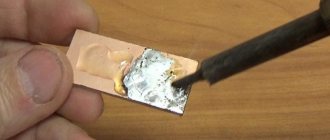If you need to sharpen your ice hockey skates, the groove size chart will be the best help for beginners to make a choice. However, if this process occurs at home, you need to know a little more about its specifics, since improper sharpening can lead to overheating of the metal, which in turn will affect the imbalance of the blade.
Many professional hockey players know how to sharpen skates specifically for their skating style, because the type of sharpening is chosen precisely according to this criterion. First of all, it is important to know the person’s weight, his position in the game - attacker or defender, how long he has been skating and how confident he is in his movements.
You should sharpen your skate blades if:
- a new pair was purchased and there is no groove on the blades;
- when turning, the blades move to the sides;
- During acceleration, slipping is felt.
It is best to sharpen hockey skates if any discomfort occurs while skating. Experts advise not to grind off a large layer of steel, but to carry out the sharpening itself regularly. After this process, hockey players balance better on the ice and can control their actions during the game, the skates glide faster, do not get confused or move to the sides, they can quickly accelerate and make sharp rotations.
Blade Profiling
The blade profile is the outline of the blade from toe to heel. When profiling the blade, you need to determine the central upper point, it is on it that the maximum load will be placed when skating, and also determine the contact spot - this is the area of the blade along which the sliding itself occurs.
A lot depends on how the skates are sharpened, so professional athletes change the geometry of the blade to suit their needs. Actually, it depends on the profile of the blade how the skates will hold the athlete during turns and braking or at the speed of gliding.
When profiling the blade, it is necessary to take into account the weight of the athlete and his skating style, because it is the profile that will be responsible for maneuverability on the ice. The greater the weight of the athlete, the larger the contact spot should be.
There are three main blade profiles and they are used in hockey, speed skating and figure skating.
Non-professional athletes use standard sharpening parameters, the area of which is 1 cm, and the radius of the edge is 14 feet. It is with these parameters that all skates are sold in sports stores.
Interesting:
If we take hockey into account, then the profile of the blade of the attacker and defender will be different, since the players have different tasks during the game.
Profile "Site"
This profile is used mainly only in Russia, the length of the platform of this profile is 50 mm, and the radius remains standard at 14 feet. At the same time, to increase the contact of the blade with the ice, the top point is cut off so that an even line with a length of 4o to 6o mm is formed.
Classic profile
The radius longitudinal profile is measured by the radius in feet. For example: 14″ designation means the radius of the profile template is 14 feet. Used for profiling the blades of hockey skates: children's, beginner hockey players and amateurs. Sharpening is done on machines according to factory patterns with a sharpening radius from 7″ to 30″.
The most popular single profile patterns for children's skates:
- for small players with good skating skills - 11″
- for beginner young players - 15″
- for beginner young players with heavy weight – 17″
Combined profile
The blade of a hockey skate can be divided into three working zones: toe, middle, heel. Each zone is responsible for performing its own maneuver (turn, turn, slide). The essence of the method. Each part of the blade has its own spot of contact with the ice. After profiling, a blade with a complex configuration is obtained. Sharpening is carried out only on specialized machines using templates. This method is popular among professional players.
Detroit Sharpening Pattern
A dual sharpening style for ice hockey skates like the Detroit 1 (10-20ft) provides the player with the most stability on the ice. At the same time, speed and maneuverability are slightly reduced. For goalies, players who skate a lot with their backs forward, and heavy defensive players, the Detroit 2 (13-26 feet) is suitable.
Zuperior sharpening template
The triple type of sharpening is used to increase balance, speed, and maneuverability. There are several Zuperior templates:
- S (6-12-26 ft) - skate blade size 24.6 cm; 25.4 cm; 26.3 cm;
- M (6-13-26 ft) - 27.2 cm; 28 cm; 28.8 cm; L (6-14-26 ft) -29.6 cm; 30.6 cm; 31.2 cm.
- V (6-17-26 feet) -29.6 cm; 30.6 cm; 31.2 cm - used for goalkeepers and heavy players.
The above patterns increase the player's stability on the ice, but have a negative impact on gliding speed. With standard hockey rinks, stability is prioritized over speed.
Sharpening Channel-Z
A special feature of this type of sharpening is the presence of an additional notch in the middle of the standard groove. It is made in the form of a square.
Channel-Z has its own sequence of sizes. The depth can be 0.8-1.6 mm. The channel width is divided into 3 types - S, M, L.
Among the advantages noted:
- Increased maneuverability and riding speed.
- Reducing resistance.
- An additional recess collects ice crumbs that melt during the game. Melted water is an additional lubricant that ensures better gliding of the skate.
Among the minuses noted:
- High cost of the service.
- The process takes longer.
- Sharpening requires professional equipment (Sweden).
- Sharpening can only be done by a highly qualified specialist.
Types of sharpening hockey skates
There are three main types of skate sharpening:
- Standard. They are sharpened in the shape of a semicircle, the channel is rounded on the inside. The size of the groove is individual, corresponding to the athlete’s body weight, the quality of the ice, for a hockey player - the playing location, for figure skating - whether jumps will be made or not.
- Channel-Z It has two grooves: a semicircular one and a square one. How much the radius should be is selected according to the same parameters as the standard one, but with a smaller coefficient. The internal second groove does not create resistance without maneuvering, but only helps during manipulations on the skating rink.
- FBV. The gutter channel has a trapezoidal shape. The superiority of this type is its rigid grip on ice and good stability. The disadvantage is very rapid wear.
Table of standard groove values for sharpening hockey skates of a forward
Table of standard groove values for sharpening defender's hockey skates
You need to focus not only on the table, but also on the player’s personal preferences. For stable skating and with turns, you should choose a sharpening with a deep groove - from 9 to 14 mm. To increase the rolling speed, you will need to increase the groove size to 20 mm or more.
Gutter table
The depth of the groove depends on the game and skating style of the hockey player. There is a table to help you choose how to process your boots:
| Player weight in kg | Beginner (groove depth in mm) | Amateur (groove depth in mm) | Aggressive skating (groove depth in mm) | ||||
| Defender | Attack | Defender | Attack | Defender | Attack | ||
| Up to 30 | 9-12 | 9-12 | 10-12 | 11-13 | 11-13 | 12-14 | |
| 30-50 | 10-12 | 10-12 | 11-13 | 12-14 | 12-14 | 13-16 | |
| 50-70 | 11-12 | 11-12 | 12-14 | 13-15 | 13-15 | 14-17 | |
| 70-90 | 12-13 | 12-13 | 15-20 | 17-30 | 14-17 | 15-20 | |
| 90-110 | 13-15 | 13-15 | 14-16 | 15-18 | 15-20 | 17-25 | |
| Above 110 | 14-16 | 14-16 | 15-18 | 16-20 | 18-25 | 20-30 | |
Proper sharpening of skates plays a big role, because the entire game takes place on an ice rink and the safety of hockey players should come first.
How to tell if your skates are dull
Skates must be sharpened regularly from the first day of use and even immediately after purchase from the store. But there are several signs when they appear that you simply cannot postpone sharpening:
- When starting to move, the skate slips.
- There is a feeling of stalling when turning.
- When you run the tip of your nail along the blade, there is no mark left on the nail plate. Look at the outline from the front. Both edges must be of equal height and a groove must be visible. When turning at right angles, the blade profile has the shape of the letter P. If other parameters are observed during inspection, sharpening is necessary.
Checking and fine-tuning
To check the quality of sharpening, you need:
- Carefully inspect the resulting cutting edge. The edges must be symmetrical, without nicks, chips, or “height differences.”
- Use a strip of thin plastic or a cocktail straw to run along each side of the edge without changing the pressure. After this, there should be no noticeable scratches or dents left on the plastic.
- Place your skates on the floor. With high-quality sharpening, they stand straight, without tilting to the sides.
- Go to the skating rink and evaluate the quality of the rental. The blades should not slip when pushing off.
If there are any shortcomings, fine-tuning is carried out. The remaining burrs from the blade are removed with a sharpening stone, a file, or sandpaper with fine abrasive particles. Then the surface is polished with a rag.
If possible, it is better to ask for an “expert opinion.” It can be given not only by skate sharpening professionals, but also by knife sharpeners. The inspection will take a maximum of a couple of minutes. Payment for it is nominal or not required at all.
Sharpening hockey skates at home
It is practically very difficult to sharpen skates at home, but recently, when almost every skating rink has a professional machine, this is not necessary. Moreover, the cost of sharpening skates rarely exceeds 100 rubles.
But if you do not have the opportunity to take your skates to a specialist, and the blades are very dull, then you need to pay attention to the following points:
- the inner and outer sides of the blade must be completely symmetrical, otherwise the center of gravity will shift and it will be much more difficult to maintain balance.
- remove the steel evenly over the entire surface of the blade, otherwise the area of contact between the skate and the ice will be greatly reduced, which will also lead to loss of balance while skating.
- do not overheat the blades; if the blade overheats during turning, the durability of the metal is greatly reduced and the service life of the skates will be reduced many times over.
- Do not under any circumstances violate the profile of the blade and the radius of the groove.
Sharpening "FBV"
For more than 25 years, a Canadian development, FBV, has been used to sharpen skates. In this case, the groove takes the shape of a trapezoid, which allows you to achieve a good efficiency when skating.
Flat Bottom “V” has a number of advantages:
- Rigid adhesion of the blade to the ice.
- Increased stability.
Among the disadvantages, athletes note the fragility of sharpening. Since the thin trapezoidal walls cannot withstand the load, roughness and chips appear.
How to sharpen hockey skates
To properly sharpen skates, you can use the following equipment: Needle file or files - necessary for direct sharpening. An abrasive whetstone or a plastic slingshot - removes burrs after the first stage of processing. You can sharpen the blade with a regular whetstone or on a sharpening machine. When using any of the listed items, it is important to follow the sharpening technology. The slightest deviation from the standards will lead to damage to sports equipment. It is best to trust a professional hockey skate sharpener.
Let's secure the information
Choose a sharpening for yourself, taking into account the characteristics of each technique. Modern requirements for sharpening skates tend to move towards European regulations. The main task is to reduce friction and effectively ride without losing speed.
Remember the basic rules for blade care to keep your edge sharp longer. Do not wear skates on hard surfaces without protective covers. Clean your blades after skating on ice. Contact a sharpening specialist regularly; do not allow the blade to wear out completely. Over time, blades lose gliding speed, resulting in poor preparation or performance on the ice.
Useful tips
The frequency of sharpening skates depends on how actively the player skates. With regular training 4-5 times a week, sharpening should be done every 3 days. Professional athletes easily feel the need to sharpen their skating quality. Young hockey players should focus on the following nuances: Socks move apart on the ice. Burrs and roughness are visible on the edge. If you run a blade across the skin, it will leave scratches.
Visually inspect the site. Important information! On the bottom of the blade the layer of metal is 1-2 mm. When sharpening, the machine removes no more than 0.1 mm. After 20 sharpenings, the equipment becomes unsuitable for riding. Another question that worries beginners is whether it is worth sharpening new ammunition. Only Reebok produces ready-to-skate skates (model with T-blade).
Subtleties of skate care
If sports equipment is not properly cared for, it will quickly lose its aesthetic appearance and fail. Moreover, attention should be paid not only to the condition of the boots, but also to the metal blades. After all, it is thanks to them that we can glide smoothly on the ice, maintaining balance when turning and braking.
How to care for your skates:
- The main enemy of metal is rust! Therefore, the blades must be cleaned of adhering snow and ice after each trip to the skating rink, and only then wipe dry the remaining metal parts (screws, protrusions, groove, etc.), put a hard cover on top and put it in a sports bag. It is also recommended to use soft covers under each blade for better drying;
- Boots must be broken in correctly, otherwise cracks, deformed areas and stretch marks may appear on the material. Proper drying of products is also important - in no case on radiators, but naturally, unlaced, inside a well-ventilated room;
- Determining the need for sharpening - visually the blade should be sharp, like a freshly sharpened knife. Also, a large number of small nicks and burrs will mean that the skates could use sharpening. The main indicator is the correct shape of the groove. It should be semicircular, resembling a concave arc.
If you have little experience or are a beginner, it is still better to take your skates to a special service and show them to a specialist, because safety on the ice comes first! In no case should you underestimate the importance of timely sharpening of skates; below you can see how to do the work yourself at home without a machine with step-by-step instructions in the video.
How to avoid mistakes
A common misconception is that any skates can be sharpened like kitchen knives, leaving only one sharp edge. This method completely deprives the athlete of stability, worsening the grip on ice, which is provided by a special groove (groove) on the blade.
Under the influence of friction of two planes of the blade formed by the groove, the ice melts - and a thin layer of water is formed in the groove, which improves gliding. Moreover, thanks to the groove, friction increases.
- The appropriate groove depth for figure skating is 5-6 millimeters.
- If skates are part of hockey equipment - 20 mm.
- For speed skaters – up to 45 mm.
Benefits of sharpened skates
Properly prepared skates have a number of advantages:
Provides improved balance and better ride control. The legs do not slip, it is easier to balance and maintain balance when turning;
Reduced friction, improved sliding quality. The friction force is less, therefore less effort is spent on skating;
Maneuverability and acceleration. You can play more aggressively, good grip on the surface provides acceptable maneuverability, you can push off harder without the risk of slipping, and accordingly the acceleration becomes sharper.
